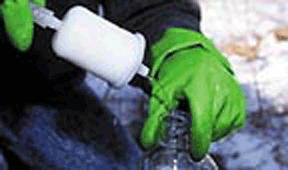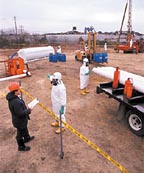

When remediating a site, follow these steps: 1) locate the source of soil and groundwater contamination, 2) remove and/or isolate the source from additional contamination, 3) recover groundwater at "hottest" spot(s) in order to minimize additional groundwater contamination, and 4) recover groundwater near the leading edge of the plume in order to minimize migration from moving further down gradient.
Admittingly, there are other remedial methods used instead of "pump and treat" such as, air sparging, introduction of oxygen, nutrients, bugs, etc. All these approaches rely heavily upon a good understanding of the site hydrogeology and the factors affecting groundwater flow at the site.
The most effective methods rely upon removing the highest mass of contamination possible (contaminant mass = concentration of contaminant x flow rate). The fastest way to increase mass removal is to increase the concentration and pump the highest levels of contamination possible.
The density of the contaminant should strongly be considered when designing the recovery system. If the contaminant is a motor fuel or light non-aqueous phase liquid (LNAPL), most likely the highest concentrations will be near the top of the water column. However, this needs to be confirmed by sampling the water column at multiple discrete depths. Heavier than water contaminants such as chlorinated solvents, pesticides and other dense non-aqueous phase liquids (DNAPLs) will tend to concentrate at the bottom of aquifers or on top of aquicludes (clays, shales, bedrock, etc.). This is where knowing the hydrogeology is real important. In some cases, lowering the screen 10 feet can increase the concentration by a factor of 10 or more. A fracture, valley or buried sinkhole filled with sand can direct groundwater flow in a direction very different than the topography. Detailed piezometer maps made from numerous piezometer/wells will help in identifying detail groundwater flow direction(s).
Finally, do not ignore observed contaminant concentrations. Piezometers/ wells highest in contamination generally have a more direct connection to the source, even if they do not appear to be down gradient. It is suggested to collect numerous cores, split spoons, soil samples and borehole geophysical logs and compare the samples from borehole to borehole. If you can't match up the layers from the cores, it is highly likely that the hydrogeology is understood well enough to design a groundwater recovery system.


Report Abusive Comment